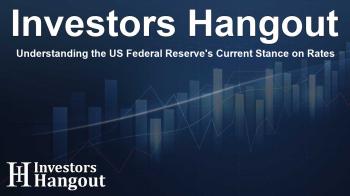Understanding the US Federal Reserve's Current Stance on Rates

Overview of Recent Fed Commentary
U.S. central bankers have recently indicated that they anticipate a more cautious approach to interest rate cuts in the near future. Anticipated cuts in 2025 are expected to be more modest compared to the larger reductions seen in past years. This reflects ongoing challenges in reaching their target inflation rate of 2%, coupled with a robust labor market and various uncertainties tied to governmental economic policies.
Monetary Policy Perspectives
The Doves vs. The Hawks
To better understand the Federal Reserve's viewpoint, it is beneficial to categorize their policymakers into two groups: 'doves' and 'hawks.' Doves typically emphasize the risks associated with labor market stability and might advocate for quicker cuts to interest rates. Conversely, hawks are more focused on the implications of inflation and tend to adopt a more conservative stance when considering rate reductions.
Key Statements from Policymakers
Recent statements from key figures, such as Fed Chair Jerome Powell and Governor Lisa Cook, illuminate the current thinking within the Fed. Cook expressed that the Fed should exercise caution with further cuts, underlining that the economy is transitioning into a new phase. Powell noted the necessity of a careful approach to monetary policy movements, especially with the incoming administration's potential policy shifts.
Continuing Trends and Future Projections
The Fed has made significant changes to its policy rate, lowering it to a range of 4.25%-4.50%. Most policymakers predict a further cut, expecting rates to settle between 3.75%-4.00% by the end of the current year. This outcome suggests a more reserved outlook compared to previous discussions, reflecting ongoing caution amidst uncertain economic conditions.
Detailed Insights from Fed Leadership
Several prominent Fed leaders have issued public comments that reinforce the cautious trajectory of monetary policy. For instance, Chicago Fed President Austan Goolsbee remarked on the importance of recognizing signs of disinflation and adjusting policies based on forthcoming data. Similarly, New York Fed President John Williams noted that while disinflation is anticipated, it may take longer than expected for the Fed's inflation goals to materialize.
Regional Perspectives
Regional Fed Presidents have also contributed to this discourse with varying perspectives. The San Francisco Fed President expressed that there should be no rush to reduce rates, advocating instead for a thorough assessment of current economic indicators before making policy changes. In contrast, Kansas City Fed President Jeffrey Schmid emphasized the need for gradual adjustments, highlighting how the economy's recent performance may influence future decisions.
Conclusion: The Path Forward
The path ahead for U.S. monetary policy is lined with complexities that central bankers are carefully evaluating. With inflation still an active concern for the Fed, future discussions will likely emphasize both the necessity for a stable labor market and cautious alignment with inflation targets. The ongoing adjustments in Fed strategies signal that while cuts are forthcoming, they will likely be measured and deliberate.
Frequently Asked Questions
1. What does it mean when Fed policymakers are labeled as 'doves'?
Doves prioritize labor market stability and often support faster interest rate cuts to stimulate economic growth.
2. How do hawkish views differ from dovish perspectives?
Hawks emphasize controlling inflation and may advocate for a more cautious approach to rate reductions, focusing on potential price rises.
3. What has the recent trend in Fed interest rate cuts indicated?
There is an expectation of more limited rate cuts in the future, reflecting ongoing challenges in achieving inflation targets alongside economic stability.
4. Who are some of the key figures within the Fed?
Key figures include Fed Chair Jerome Powell, Governor Lisa Cook, and other regional Fed presidents who all contribute to monetary policy discussions.
5. Why is the labor market's performance significant for the Fed?
A strong labor market can influence Fed decisions on interest rates, as it impacts inflation and overall economic health.
About The Author
Contact Dominic Sanders privately here. Or send an email with ATTN: Dominic Sanders as the subject to contact@investorshangout.com.
About Investors Hangout
Investors Hangout is a leading online stock forum for financial discussion and learning, offering a wide range of free tools and resources. It draws in traders of all levels, who exchange market knowledge, investigate trading tactics, and keep an eye on industry developments in real time. Featuring financial articles, stock message boards, quotes, charts, company profiles, and live news updates. Through cooperative learning and a wealth of informational resources, it helps users from novices creating their first portfolios to experts honing their techniques. Join Investors Hangout today: https://investorshangout.com/
The content of this article is based on factual, publicly available information and does not represent legal, financial, or investment advice. Investors Hangout does not offer financial advice, and the author is not a licensed financial advisor. Consult a qualified advisor before making any financial or investment decisions based on this article. This article should not be considered advice to purchase, sell, or hold any securities or other investments. If any of the material provided here is inaccurate, please contact us for corrections.

